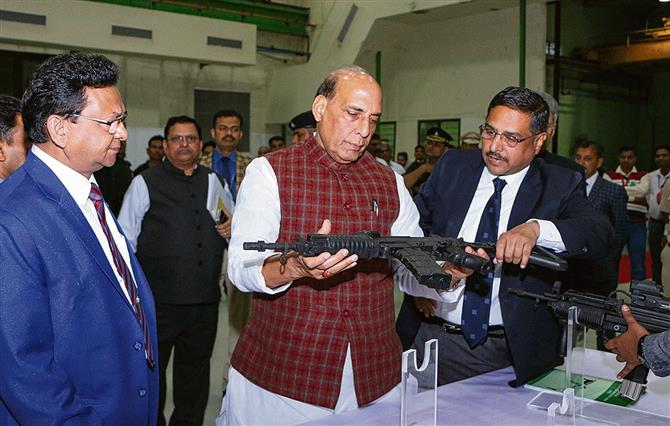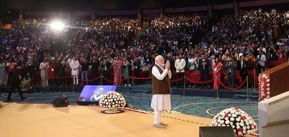
Beneficial: India has begun to use the startup ecosystem to gain cutting-edge capabilities. PTI
TK Arun
Senior Journalist
FANS of philologist JRR Tolkien and his lore would be familiar with Anduril and Palantir as, respectively, a magical sword and a crystal ball that shows things afar, including in the past. But Anduril and Palantir hitting the headlines are not magical relics of yore, but defence companies that came up from America’s technology startup ecosystem to develop high-tech military capability, and figure among the defence startups proving their spurs in the war in Ukraine.
China is preparing for the high-technology denial regime in which the US wants to cage its acknowledged systemic rival.
A Chinese unicorn has successfully produced microchips with circuitry that is 20 micron thick. That is a far cry from the 7 or even 4 micron circuits that power the latest generation of advanced chips from Korean and Taiwanese companies that are under American pressure to stop selling their ware to China or Chinese companies. Dozens of unicorns are coming up in China in the areas of microprocessors, robotics and artificial intelligence, as China races to prepare for the high-technology denial regime in which the US wants to cage its acknowledged systemic rival, to cap its capabilities in areas of core strategic competence.
India has also begun to use the startup ecosystem to gain capabilities that Indian companies do not have, that are vital to achieving and retaining strategic parity with other major powers and are at risk of being withheld by foreign suppliers, if access to them is managed entirely through imports. India has to do a whole lot more in this area; it has the requisite talent, opportunity and financial resources.
In this light, a recent initiative by defence shipyard Garden Reach Shipbuilders and Engineers Limited (GRSE) is most welcome. The GRSE has launched the GRSE Accelerated Innovation Nurturing Scheme (GAINS) for young entrepreneurs. The difference between GRSE opening its purse strings to any promising startup that could offer innovations in the company’s area of business and GAINS is that GRSE would first let would-be entrepreneurs familiarise themselves with its operations, so that would-be innovators know where innovations are possible and of what kind.
We are familiar with tales of Israeli youngsters coming out of their compulsory stint of military service with ideas for new technology that would aid the military work, and getting down to it, once they have let down their hair for a while on the heady slopes of the Himalayas. India’s bright young minds who join the military have a martial bent of mind and plan to become career officers, rather than tech entrepreneurs. So, in the Indian context, those who have domain knowledge of defence and those who possess technological or entrepreneurial capability tend to be two different sets with nil or minimal overlap. This cannot be overcome by liberal funding of military startups alone.
When Covid struck, and India stared at an alarming shortage of ventilators, many agents came together to deconstruct the ventilator machine, identify its parts and components and those who could manufacture them. This swiftly resulted in the ability to produce ventilators in plenty. This method can serve as a rudimentary approach to encouraging startups in defence tech. This would help with indigenising and improving what already exists. It would not help innovative minds work on what could be. For that, those with an entrepreneurial orientation must be exposed to the work on the field of different wings of the armed forces, their planning and administration.
India faces multiple challenges in military capability. One is attaining parity or exceeding it in warfighting capability in terms of raw hardware capability. Another is the ability to integrate the diverse bits of hardware into information networks that yield analysis, integration of the results into actionable intelligence, again distributed among different execution agencies, to be acted on, with precision and speed. This second challenge is related to the new challenge our armed forces are grappling with — unified command and jointness.
There is much glib talk of artificial intelligence (AI) as a solution to complex decision-making. At present, the internal working of AI is a black box. If a piece of AI were to analyse information gathered by satellites, drones, spy craft, electronic eavesdropping and much else and propose that action X be undertaken by division Y of the infantry, rather than a strike by Air Force fighter planes as conventional analysis would indicate, would our Air Force and Army brass agree to bite their tongues and defer to the algorithm? Or should the aim be to develop automated decision-making that can articulate its reasoning and rationale?
Can we offer final-year engineering students a choice to serve two years in the Army, to learn how it works, and think of what could make things work better? A rigorous process of selection could filter out a pilot batch of, say, 100 tech apprentice soldiers who are rotated through different parts of the services, spending time on operational aspects rather than on spit and polish, to see with fresh eyes what is done, what more could be done, and done differently. They could come out of the Army, submit projects to develop their solutions, for part-funding from the defence establishment, with the rest of the funding to be mobilised from venture capitalists more familiar with the feasibility of projects than colonels trained to see ‘can’t do’ with contempt.
The deconstructed ventilator model might be more appropriate for the chipmaking ecosystem. For true autonomy, India would need to make not just the chips, but chipmaking equipment as well. Instead of still thinner copper circuits created by flowing the vaporised metal into micro-grooves etched by laser on to silicon wafers, can we replace the electrons with photons?
For a viable startup system, we need not just liberal startup funding, but much larger outlays on R&D in general as well, to drive research in basic science as well as technology, so that the pool of knowledge and talent that the startup ecosystem can draw upon is wide and deep enough.
Half the publicity outlay of the government could be diverted to this end, perhaps?
Join Whatsapp Channel of The Tribune for latest updates.




























